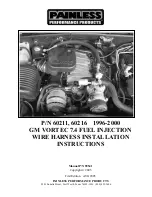
23 AERODYNAMIC INFORMATION
¾
Front wing main-plane and rear lower wing are set relative to the chassis reference plane.
¾
The optimum setting for the front main-plane is –0.6° [nose up]. Any chassis rake angle will
alter this setting.
¾
Front flap inclination is intended to be the angle, relative to the chassis reference plane,
measured on top of the flap front and inside the Gurney ‘corner’.
¾
Rear top wing assembly inclination is intended to be the angle, relative to the chassis reference
plane, measured between the front of the flap, on top and the rearmost trailing edge. Any
chassis rake will affect the angle.
¾
Front and rear ride height settings are fundamental to the aerodynamic balance and ultimate
performance of the car. Pay attention to the changes between static setting and the dynamic
values, at speed, on the track.
MINIMUM
MAXIMUM
HOLE
INCIDENCE
HOLE
INCIDENCE
FRONT MF FLAP
A1
7°
G4
34°
FRONT SF FLAP
A1
10°
G4
37°
REAR TOP MDF WING
A1
0°
F2
11°
REAR TOP HDF WING
A1
2°
D4
23°
REAR LOWER (std)
-1°
10°
REAR LOWER*
7°
18°
*requests different rear wing supports, available in Dallara
HOW TO KEEP THE BALANCE FOR SMALL CHANGES
HOW TO BALANCE
+1° FRONT FLAP
BY ADJUSTING:
1.
TOP REAR WING
2.
REAR RIDE HEIGHT
3.
FRONT RIDE HEIGHT
Front
flap type
Rear top:
MDF
Front
flap type
Rear top:
HDF
1.0 holes
RR top
1.3 holes
RR top
1.4mm lower
RR ride height
1.9mm lower
RR ride height
MF
0.5 mm higher
FR ride height
SF
1.2mm higher
FR ride height
MF
: FRONT MEDIUM FLAP;
SF
: FRONT STANDARD FLAP















































